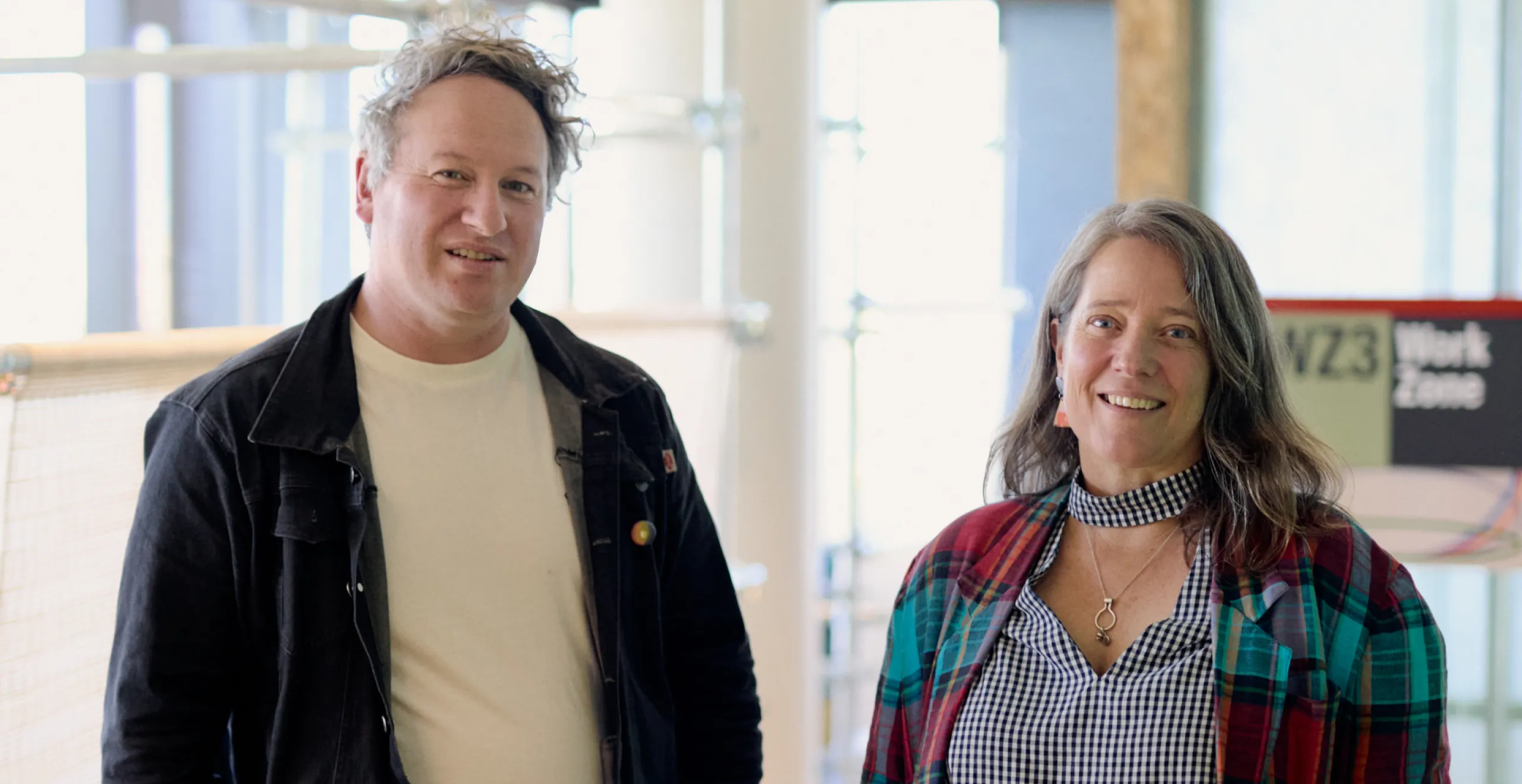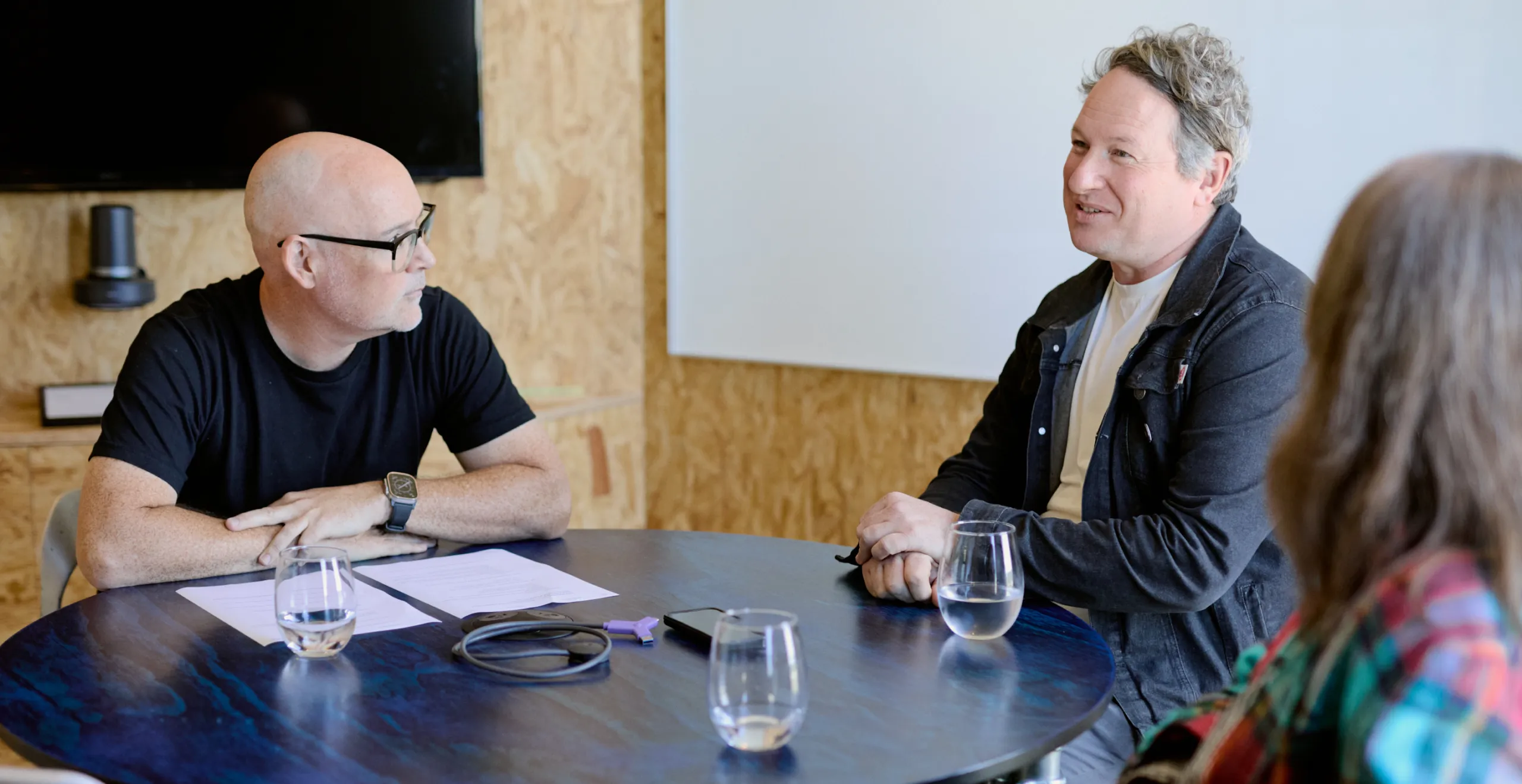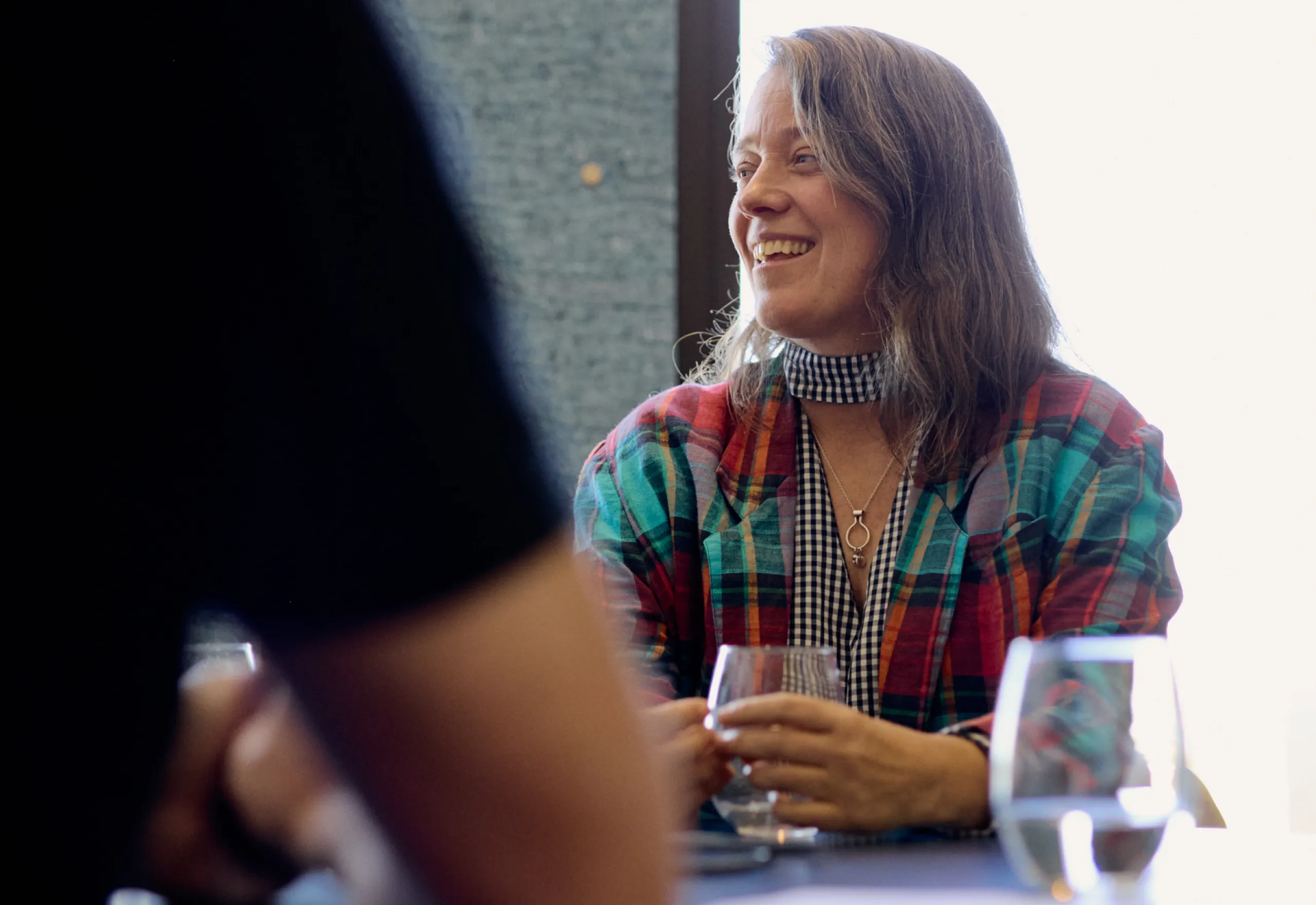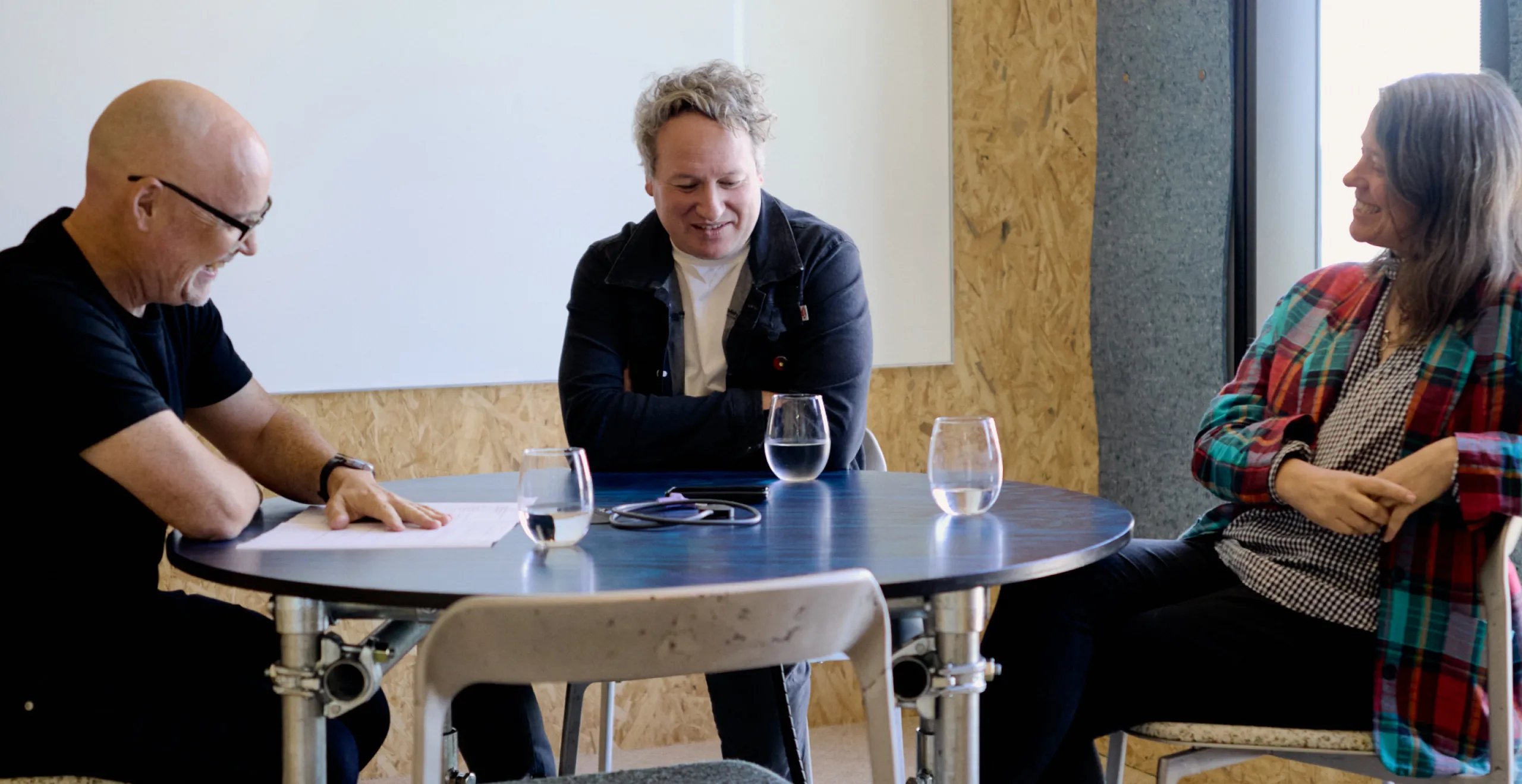History can tell us a lot about where we’ve come from and what has come before us. But for it to have real value, we need to ask whose perspective we’re listening to.
Ashtree Projects was founded with a desire to help organisations with complex histories learn from the past to build a better future.
We caught up with Co-Directors, David McGinniss and Ember Parkin, to learn more about the importance of openly and authentically engaging with history.
David McGinniss, Director and Principal Historian at Ashtree Projects
Ember Parkin, Director at Ashtree Projects
Mark Davis, Head of Digital at Today

Ember: I'm Ember Parkin. I am a co-director of Ashtree Projects. In my career, I've done a little journey through looking at history and heritage through museums through to placemaking and community engagement. Community engagement is a big focus of my world now.
I have a PhD in sociology ethnography, looking at young people's relationship with place in small country towns. I also have a Master's of Public History and Heritage and although I love theory and academia, I never wanted to be an academic. I always sought to have more of an applied approach, which is why we started Ashtree Projects.
David: I'm David McGinniss, I'm co-director of Ashtree Projects with Ember. I'm a historian and I love describing myself that way because it's what I always wanted to be when I was a kid.
I had a bit of a career change after many years in social policy, and social services in government and community organisations. When doing strategy, policy, and service delivery we would always be talking about the present—what's the service delivery now, what's the future state, and what do we need to move into. And I always thought that we're actually building from what's come, rather than only building for the future.
Why is history important to both of you?
David: The driving force behind wanting to become a historian and becoming a historian is how can we use that knowledge and that perspective to better inform service delivery, service planning and strategy into the future. It's not necessarily a reverence for the past or an idea around preserving the past, it's actually understanding the past to then know what we can change. Which of it has just been invented? So many of these systems that we work within now are just invented systems that were invented to suit the time in which they happened, and we inherit them. That's a really strong motivation for an approach to history and critical history and applied history as we describe it I guess.
Ember: When I did my Masters and earlier consulting work, I was looking at the purpose of history—not informing the current practice of services organisations—but what does that mean for the audience of history? What is the identity value? What is the meaning that can be created from history and how does it affect people now?
It's not necessarily a reverence for the past or an idea around preserving the past, it's actually understanding the past to then know what we can change.
David McGinniss
What is the identity value? What is the meaning that can be created from history and how does it affect people now?
Ember Parkin

How did you two come to form Ashtree Projects?
Ember: After we finished our PhDs we had a desire to keep working on things together. The City of Ballarat was the reason we formed our business. Council officers wanted us to work with former residents of the Ballarat Orphanage and Ballarat Children’s Home to develop a place-based historical interpretation at the site of the former institution.
The site is owned by private developers and a development plan was signed off several years ago, which had a historical interpretation plan. But once the City looked at it, they realised that it was developed with no voices of the former residents - and they were the people who campaigned for heritage protection and who had a vested interest in seeing the site’s histories shared.
Thankfully, heritage officers at the City of Ballarat knew they couldn't let that slide and they made sure that the activist voices of the former residents were included.
David: I kept being invited to meetings about the development, "Oh, you should invite that guy Dave." And so I'd come along and then eventually one of them said, "Hang on, you should probably be paid for this because you're spending a lot of your time." I was like, "Oh yeah. Okay. That's interesting, all right." And then I think I might've looked into getting an ABN.
That's when we realised we could make this formal, it could be a way for Ember and I to work together.
In that moment when you came together, did you have clear roles or was it more, let's just throw our brains at this problem?
Ember: Ashtree comes from ASH, which is applied sociology and history. I'm the sociology and he's the history, even though I love a bit of history myself.
David: And vice versa. And the tree just makes it seem like it's alive.
Ember: Initially we formed Ashtree to do that one specific project and we thought, "If we just do this project, that's fine. We’ll form a company and get public liability insurance and we'll do this one thing and we'll see what happens."
And then we had the opportunity to continue working with former residents of the Ballarat Orphanage and Children’s Home, through some work with Cafs, which then kept on growing and morphing into different things.
So tell us about how you started working with Cafs?
David: The PhD that I wrote was a history of the Ballarat Children's Home, which in various guises is from 1866 to 1983. It was an orphanage essentially, a large-scale, mass residential orphanage. In 1983 it stopped being a mass facility for 200-plus children and became more of a community-based organisation which is part of a broader trend and broader practice change in the '70s, '80s and so on. Through various name changes, it has evolved into this modern community sector organisation called Cafs, (Child and Family Services Ballarat).
I had an incredible supervisor, Jacqueline Z. Wilson, and II learned from her the value of applied activist history and how to delicately, but also firmly, push the boundaries of conventional history. My approach was ethnographic history. So it’s the thick description of the cultures of the past rather than using historical records as the verification of what did or didn't happen. You're trying to understand the cultures and then go through that.
Ember: So before we started Ashtree, when David was working with Cafs on his PhD research, he helped them get a grant for them to do some archival records documentation. From this, I came in for some casual contracting work and created an index with over 10,000 entries of references to individual children from old superintendent reports—with the aim of making these records more accessible to the people they’re about.
After doing that piece, I made some recommendations to them about what to do next. They needed some support to get their archive in better order. They needed a more strategic approach to how they managed their history and they needed to build on partnerships.
So the first job that we did as Ashtree for Cafs was to develop a strategy for history and records. We consulted with the former residents of the orphanage and children's home from the institutional era of their organisation and worked with them to develop a strategy that would help them to move forward.
David: The heart of the strategy that we wrote was, "Your history is our responsibility." So this notion of who owns the histories. Previously there was a corporate view that it's the organisation that holds the records, owns the records. So it’s up to them to tell the story and that's where you would write a coffee table book or do a museum style exhibition.
But I think the heart of the strategy that we did is, "No, these are your records." meaning those who grew up in care in this institution. And it's our responsibility to be looking after them and when you want them, they are yours. We've just been looking after them.
The heart of the strategy that we wrote was, "Your history is our responsibility."
David McGinniss
On your website, you use the words "strategy activation". What does that mean?
Ember: Yes. So since we developed this strategy we've done a range of activations including running collaborative art projects and co-creating a history exhibition. Cafs had a very beautiful, very high-quality exhibition about the history of the Ballarat Orphanage. But unfortunately at the time that it was developed, it didn't consider any voices of the people who lived there. It was more from the perspective of the organisation and staff.
David: It was a corporate version of the history. It was telling the history of its own organisation as an asset.
Ember: The feedback from the past residents who visited, initially they would be very impressed and say, "Wow, this looks amazing."
And then they would get into it and feel like, "Oh." Either have some really strong critiques about why that image shouldn't be used or, "Where's my voice, where's my experience?”
David: Yeah, they're left feeling quite cold.
Did you have conversations about themes of transparency or lived experience before starting?
Ember: It was absolutely embedded in the rationale for why we did the thing and why we would even bother redoing it. Getting the ex-resident's response was instrumental in guiding us towards making any changes at all.
David: And there was constant communication up and down the organisation. We got to know the board, we got to know the managers, we got the workers, we got to know the ex-residents.
Ember: So we worked with a group of ex-residents and had a couple of open exhibition development days to look at how we reframe those stories to be in service of the people that lived in the place.
I think for us it was about changing the audience. Previously it felt very geared towards the public, funders, and school group tours.
David: The Royal Commission was happening, the Forgotten Australians report had happened, and the Bringing Them Home report had happened. We're living through a historical era, which has been theorised as an age of testimony in which the voices and the perspectives of lived experience have been incredibly influential in the development of policy and the development of these reports.
We're living through a historical era, which has been theorised as an age of testimony in which the voices and the perspectives of lived experience have been incredibly influential in the development of policy...
David McGinniss
How did you bring the voices of the ex-residents into the redesign of the exhibition?
Ember: Very collaboratively. We came up with a lot of ideas and suggestions and they were constantly improved by the working group. It was very iterative. There was a mixture of approaches from gathering stories from existing archives, biography and testimony, and then grouping, theming, and refining, and sharing with ex-residents, and then getting more snippets of stories and experiences as their memories were sharpened.
We came across this incredible graphic designer, Kerri Wilson McConchie who made it look so beautiful, and is a former resident of the Children's Home herself.
We had this incredible moment where we were briefing her about the different documents and archival materials that existed that could be used to create. And we have this one little holy grail of a document in the archive at Cafs, which is this magazine called Look Around which is the only edition of a children’s written and instigated newsletter of the children’s home. It’s a beautiful little zine with drawings of ‘guess who’ of the staff. And when we brought this out to Kerri, she said, "I wrote it."
She couldn't believe it was there. She'd completely forgotten about it. She said, "Yes, that's me." And then we saw her name on it.
David: Without talking too much on her behalf, I do remember her looking at it and going, "Oh my god, this was my first design job."
And now she's a designer and an artist.
Making a connection with someone like Kerri is amazing. It’s a priority to enable connection rather than protect ideas from being moved around.
...it's the right thing to do. There are difficult histories and we need to be honest. As a society, as a community, if we're honest with ourselves and if we are genuinely committed to truth-telling, then it's truth-telling about ourselves and our organisations, no matter how difficult that might be.
David McGinniss
Why are organisations now better at acknowledging the past than they were a few years ago?
David: One element is that it's the right thing to do. There are difficult histories and we need to be honest. As a society, as a community, if we're honest with ourselves and if we are genuinely committed to truth-telling, then it's truth-telling about ourselves and our organisations, no matter how difficult that might be.
As well as that, it's also strategically a really important and necessary thing to do. Because if you think about an organisation like Cafs, the broader community perspective has been brought along by the Bringing them Home Report , by the National Apology to the Stolen Generations , and so on.
So if they're telling a story and they've got an identity that is out of sync with the rest of the community, that is not good for them. They're an organisation that is dependent on community goodwill and community contributions. And if they're not in line with community expectations, then that's strategically a bad move for them.
Ember: I think there’s a growing awareness and acceptance of how lived experience shapes people’s engagement with services. Our projects have had us reflecting on this for our own selves as well. I had an experience of living in a cult in early childhood. Stories from that place were recently heard at the NZ Royal Commission of Inquiry into Abuse in Care.
I used to talk about that part of my own history like an oddity, something that gave me a sense of difference in a way that was quirky. But working through these kinds of projects with Ashtree has led me to investigate more internally, what are the impacts of that lived experience for me? How does it still live in my mind and body? How does it position and drive what I do now? I still haven’t got to a place where I have fully resolved the connection, but I know there's a link there, and see that doing the work to investigate this is vital to my ability to keep on going with this kind of work.
Likewise, for the organisations that we work with, I think that there's a big piece around genuinely owning identity and being able to move through organisational traumas of the past.
I think there’s a growing awareness and acceptance of how lived experience shapes people’s engagement with services.
Ember Parkin
David: You've got to be aware of what the versions of history are, but it's even more pragmatic than that. I think organisations that aren't honest about their histories will have trouble attracting and retaining staff, particularly in the care or social services sector, because people need to believe in the authenticity.
Ember: Because if you are trying to obscure or hide or gloss over, it's the same as what we are as people, as human people. If you try and just gloss over it and just go, "No, we'll be right, we'll just keep moving forward, keep moving forward." It's going to come up as a big belch… it’s going to repeat.
It helps staff and it helps the organisation to build on its identity to actually move through its own trauma. These organisations that have really complex and difficult moments in their past are continually affected by them.
David: It’s about knowing what you can get rid of, knowing what is essential, and what is actually just something that was picked up 10 years ago, 20 years ago, 50 years ago that we still do. History is a really useful tool for understanding what's important.
On that pragmatic level as well, there's an organisation that we've worked with—Drummond Street Services — that had so thoroughly forgotten its own history that it didn't realise that it had been part of the out-of-home care system in decades past.
So when a case of abuse was uncovered through the national redress scheme, it fundamentally challenged its perspective of itself as an organisation.
And that has a ripple effect on everyone; leadership, staff, clients, everything. This sense of, we are not who we thought we were.
Ember: And this organisation was very well documented, and has a lot of history written about itself. But over time, it chose to remember things that reinforced what it was proud of.
We found that one of the big benefits when an organisation engages openly and authentically with history, it can really enliven organisational values. Exploring what that means to the staff as a collective, and seeing that staff can connect through values, and through openly interrogating their history.
When an organisation engages openly and authentically with history, it can really enliven organisational values.
Ember Parkin

What kind of process would you use on the ground to work with an organisation in processing its history like this?
Ember: So in the case of Drummond Street, the response was to have us come in and help them and all of their staff to collaboratively interrogate and emotionally respond to the history. We tried to apply a trauma-informed way of organisationally processing this harm that had occurred in their past. We did this through looking not just at the detail of this one negative situation, but what is the whole of their history? How can they be more critical about reflecting on their history? How do they feel about this? What's important?
In group settings, we enabled them to have time collectively to feel through different elements of the histories.
David: There was a fear around these difficult histories. It was this black hole of no information and people felt scared to even approach it. Not to say that you shouldn't be afraid of your difficult histories, but to realise that yes, it is part of our history and we can address it and own it.
Ember: Organisationally, another outcome of this was that people could objectively say, "I see why, now that there was hesitancy for change there, but I can see that that change was good. So maybe I can be a bit more accepting of change now."
David: It provides hope for people who are seeing the changes happening too slowly. Instead of feeling despair about the lack of change and the lack of progress, history provides you with an opportunity to re-energize.
If you were advising a leader of an organisation with a complex history, what would that look like?
Ember: Bravery is worth it. It's important to be able to work through what's uncomfortable.
David: It's going to cost you way more to hide this. Both operationally and culturally.
Don't see it as a sunk cost or as an additional extra or a nice thing to have if you've got some spare money at the end of the financial year. Build it into your fundamental view of who you are.
Every organisation will invest in their strategy. Build your consideration of history into your strategic work.
Bravery is worth it. It's important to be able to work through what's uncomfortable.
Ember Parkin

What does your dream opportunity look like for creating a positive impact in the world?
David: I'm now working with the University of Melbourne in social and political science in a partnerships role. So it's really about connecting students, sector, industry and academics, to create opportunities for students to make that positive impact in the world using the skills of social science, political science, and strongly includes considerations of history.
It's the connection between different elements and then the expansion of an application of knowledge rather than the contracting and diminishing of knowledge. So yeah, I would love for students and young people from all sorts of backgrounds to be able to learn and connect that applied sociology history like we've been doing, and create all sorts of fun.
Ember: For me it's weaving together the views, feelings and experiences of the lived experiences of people. If I can find a space where we can collaborate with people—people with lived experience of past institutional harms—and we can work through with them to an outcome that they feel happy and proud and excited about, that's my sweet spot.
